



“Make your own road,” says the off-roading instructor seated next to me as I navigate the all-new Suzuki Jimny over a pile of rocks.
He’s not spouting a worn-out marketing slogan. The norm with several media drives is to allow you to “explore” the capabilities of an all-new machine while the brand all but guides your steering wheel towards a carefully curated set of obstacles, with ruts clearly carved out of repeated driving. It’s an illusion of adventure.
Not this time. Maruti Suzuki knows what the car is capable of. And I suspect, is ok with a broken differential or two, as long as the driver steps out of the vehicle a convert.
That should clue you in as to just how confidence-inspiring the Jimny is. It’s been a long time coming, but it was a crucial addition to the SUV portfolio of a brand that’s yet to cover some ground on that front. The Jimny arrives, with its classical good looks, its purposeful design and its alleged terrain-conquering capabilities, just in time to bolster Maruti Suzuki’s SUV line-up and add a level of credibility that even the Grand Vitara couldn’t.
Design
It certainly looks the part. The Jimny has, even in its five-door guise, managed to become one of the most exciting pieces of modern car design, not only in its segment but in cardom.
Sure, you can argue it’s derivative, and the G-Wagon resemblance isn’t accidental but no one’s complaining because the democratisation of stellar design is a desirable thing.
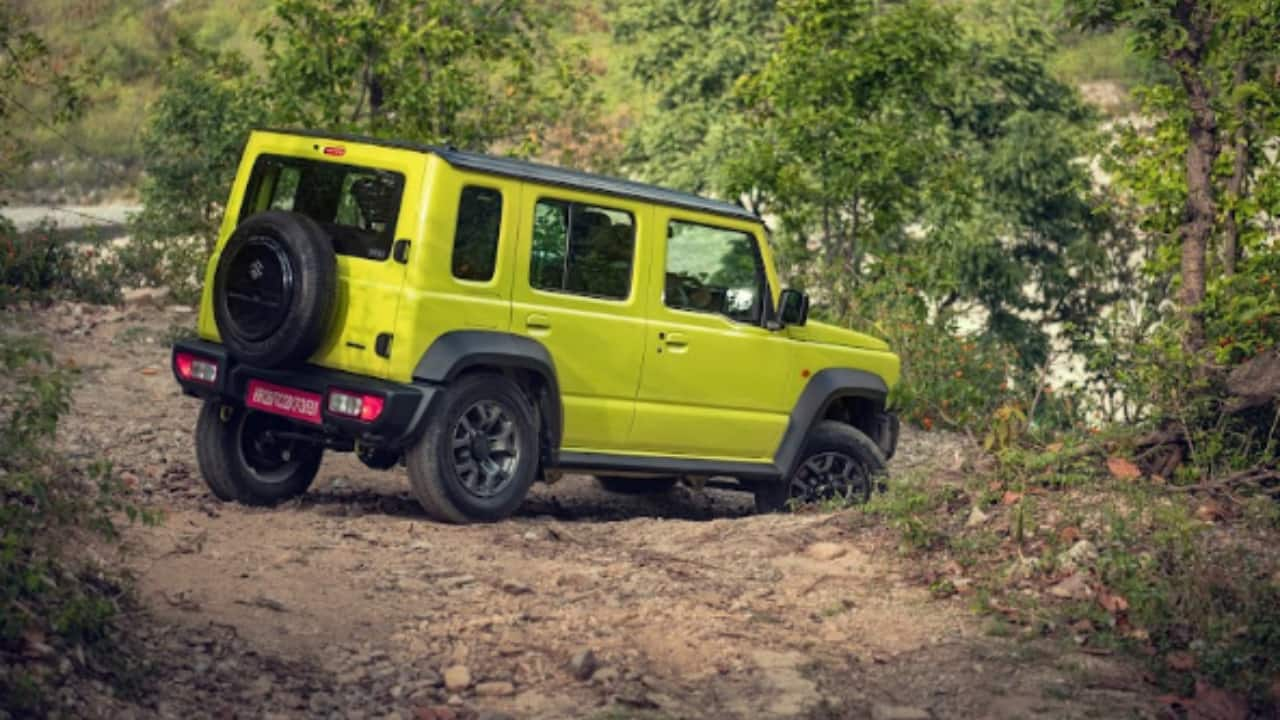
And the Jimny looks funky as hell. Perhaps the timelessness of the traditional, ladder-frame rectangle with circular headlamps, a clamshell bonnet and a sideways opening tailgate remains so because it’s a rare interlude in a barrage of busy designs. Because driving past the usual crop of Balenos, Swifts and WagonRs – three of the most commonly sighted cars in the country – you can’t help but wonder why more cars aren’t designed to possess the simple elegance of the Jimny.
It’s also a very functional design. Large plastic bumpers and wheel arches surround the upright frame, allowing for entry and departure angles of 36 degrees and 50 degrees, respectively. In what marks a refreshing change, the taillights have been integrated into the rear bumper, allowing the Jimny to have a fortress-like, uncluttered rear design, punctuated only by a large spare wheel.
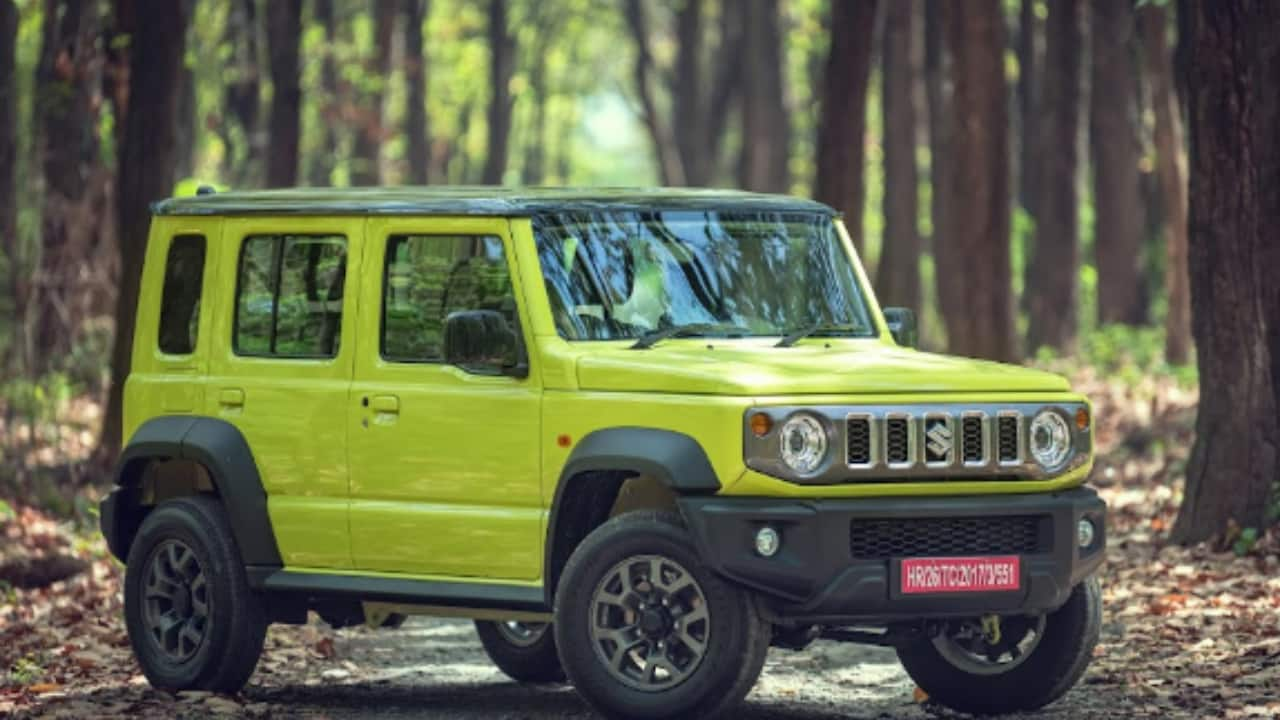
When the first fan renderings of the five-door Jimny surfaced on the Internet, I’ll admit I was a tad disappointed at the lack of proportion. The three-door Jimny was nigh on perfect, and the addition of an extra couple of doors and windows seemed like an unnecessary intrusion on what is bound to become a future classic piece of design, much like the original Gypsy.
But that’s the internet for you. Seeing the five-door version in the metal at the Auto Expo, it was evident that Maruti Suzuki executed the task to perfection. The rear cabin window’s size has been proportionately truncated, sharing space with the one near the C-pillar.
Interiors
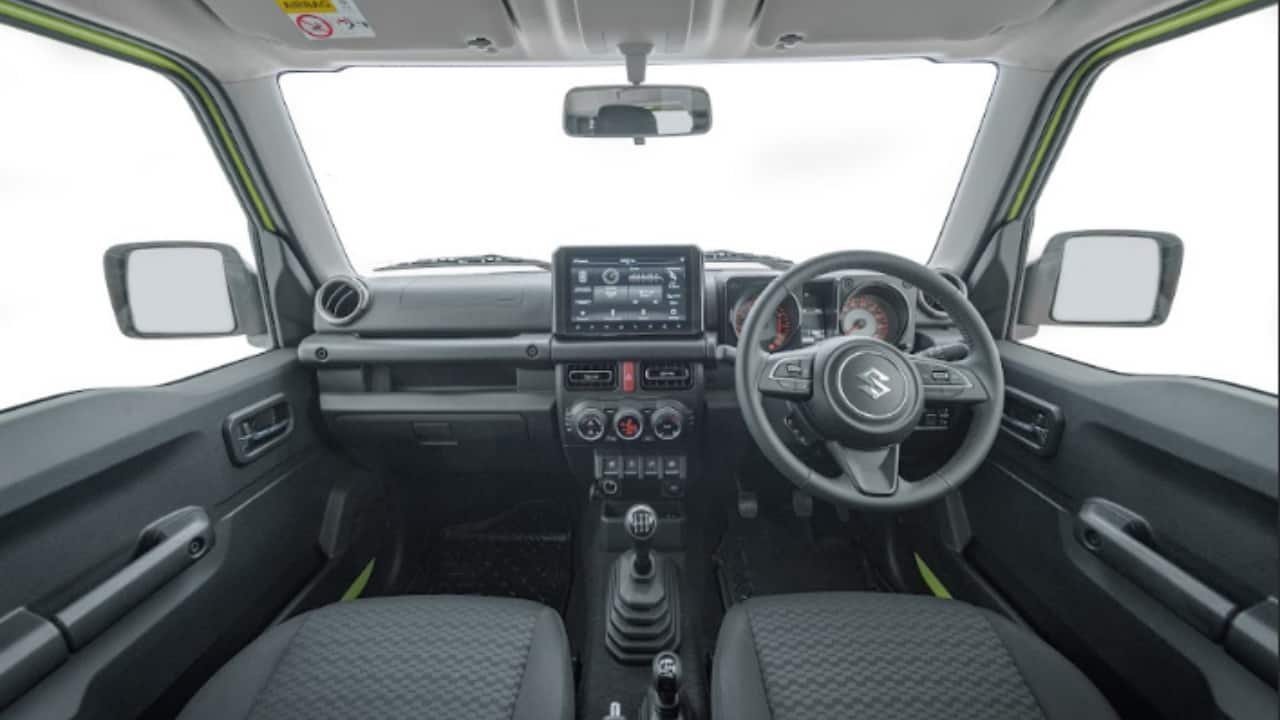
The same practical, neo-retro treatment has been meted out to the interiors, which, with the exception of the rear bench, remain identical to the 3-door Jimny, The view is optimal, if not domineering, while the dashboard gets all the bells and whistles you’d expect from a hardcore off-roader, including a dash-mounted grab handle for the front passenger, and, of course, a manual transfer case to switch from 2H to 4H or 4L. There are no terrain-based off-road modes, and Jimny’s deliciously analog driving experience is much more enriched as a result of it.
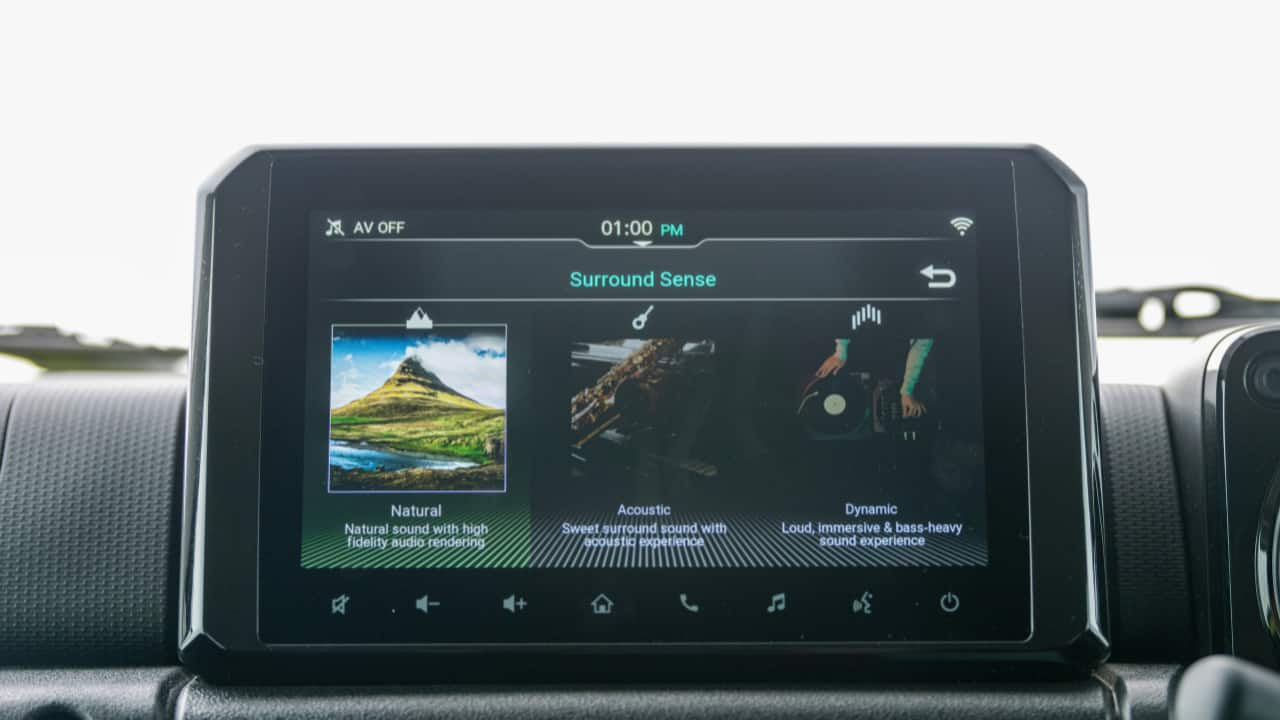
A 9-inch touchscreen system featuring Maruti Suzuki’s own Smart Pro interface. Sits atop the dash (in cheaper trims, it’s the 7-inch screen). Wireless Apple CarPlay and Android Auto are also part of the deal, although a wireless charger isn’t. Which is absolutely fine, but the total absence of a storage pocket for the phone isn’t.
In fact, the cabin is a bit low on storage space in general, with the space flowing down from the centre console being occupied by two gear levers, leaving room only for small pockets designed for cups and keys.
But it is a fabulously appointed space, with top quality materials, rubberised knobs and a crisp analog gauge cluster and chunky, tactile retro switches to engage the front power windows, hill hold control etc. There’s no silly stuff like a sunroof. This is a purpose-built machine for the urban adventure seeker. And it looks the part, both inside and out.
Driving the Jimny off-road

Make no mistake, the Jimny is, first and foremost, a highly optimised off-roading tool. It gets only one powertrain and that’s the K15B 1.5-litre NA petrol engine. No turbocharging means this unit puts out a modest 103 bhp of power and 134 Nm of torque, which sounds pretty underwhelming on paper, especially considering how dreary the mild-hybrid Grand Vitara’s straight-line performance is.
Then you come to the off-road kit, which is by far the best in its class. You get brake-limited slip differentials on both axles, allowing the vehicle to not only send power to the wheel with the most traction but also to pump the brakes on the slippery one. Both axles are rigid, featuring multi-link coil spring suspension allowing for greater travel on undulated surfaces and more durability than the independent units found on, say, the Mahindra Thar.

The transfer case is as old school as they come, with a solid “clunk” sound emanating from underneath the floorboard whenever you push the lever down and slot it into 4L. The switch from 2H to 4H can be made on the fly, and you can choose between the robust 5-speed manual or a 4-speed torque converter. The latter is also optimised for off-roading with D2 mode keeping you in second gear all along, while ”L” keeps you in first; you crawl over rocks in 4L.
Driving across a dried-up riverbed near Dehradun, the Jimny was thrown into the literal deep end. Short overhangs, a ramp-over angle of 24 degrees and a simple robust off-roading kit make this a promising experience. Actually, this is the understatement of the year. The Jimny takes to undulated terrain like a mountain cat. It’s agile, nimble and most importantly, it remains unfazed no matter what you throw at it. I can’t recall the last time I had an off-roading experience that filled me with confidence and felt so enabling. Everytime you brace yourself for the bumper making contact with a rock, the Jimny just scuttles over a boulder with effortless ease, its softly sprung suspension always finding a way to make contact with terra firma, no matter how uneven the surface.

With a ground clearance of 210mm and water wading depth of 310mm, there’s practically nothing the Jimny cannot be pointed at and driven over. The Gypsy was famous for scuttling-up near vertical surfaces with ease thanks to its light kerb weight, and the Jimny does exactly that. In fact, it descends from near-vertical surfaces with equal ease, given the hill descent feature, which doesn’t require you to so much as tap the brakes. No two ways about it, the Jimny is the most capable and fun off-roader in its segment by a country mile. In fact, it’s a more effective and easy-to-run off-road tool than pretty much anything in the market. Sure, there are more plush 4x4 capable off-road vehicles with a ladder-frame chassis. But south of the very bouncy Toyota Hilux, there isn’t anything you’d feel quite as confident about thrusting into the most treacherous terrain.

The Jimny’s plastic bumper and cladding remain easy to fix, and Maruti Suzuki’s legendary service network means that spares will remain cheap and easy to find. A dream for any off-roader. It’s a wonder why Maruti Suzuki took three decades to bring the Gypsy’s successor. I fully expect the country’s growing tribe of off-readers to waste no time in equipping the Jimny with a winch, a roof rack and a snorkel. Unlike most alleged “off-roaders”, there’s zero bluster here, just pure capability.
On tarmac
This is where things, expectedly, face a compromise. The 1.5-litre NA unit on the Jimny, while perfectly adequate in off-roading scenarios, struggles to keep up with highway traffic at highway speeds. Although I’m yet to drive the 4-speed automatic, the slightly agricultural nature of the 5-speed manual means frequent downshifts to find the meat of the powerband. And even then, delivery is frustratingly linear. It gets up to highway speeds, but you will find yourself yearning for a turbo to kick in.
The softly-sprung suspension does wonders for Jimny’s overall ride quality. In fact, its damping is one of its strongest attributes. However, there’s some expected level of body roll given the ride height, suspension damping and chassis set-up here. It’s very contained at low speeds and isn’t an issue for city driving. But highway driving will keep you pumping the brakes.
A worthy successor to the Gypsy
In pre-privatisation India, the Gypsy was the most modern off-roader in the country, despite its leaf sprung suspension and modest engine capacity. Its light structure and robust frame went a long way in making it everything from a military aide to a rallying icon, leaving a legacy that few cars possess. The Jimny is as worthy a successor to that car as a brand can hope.
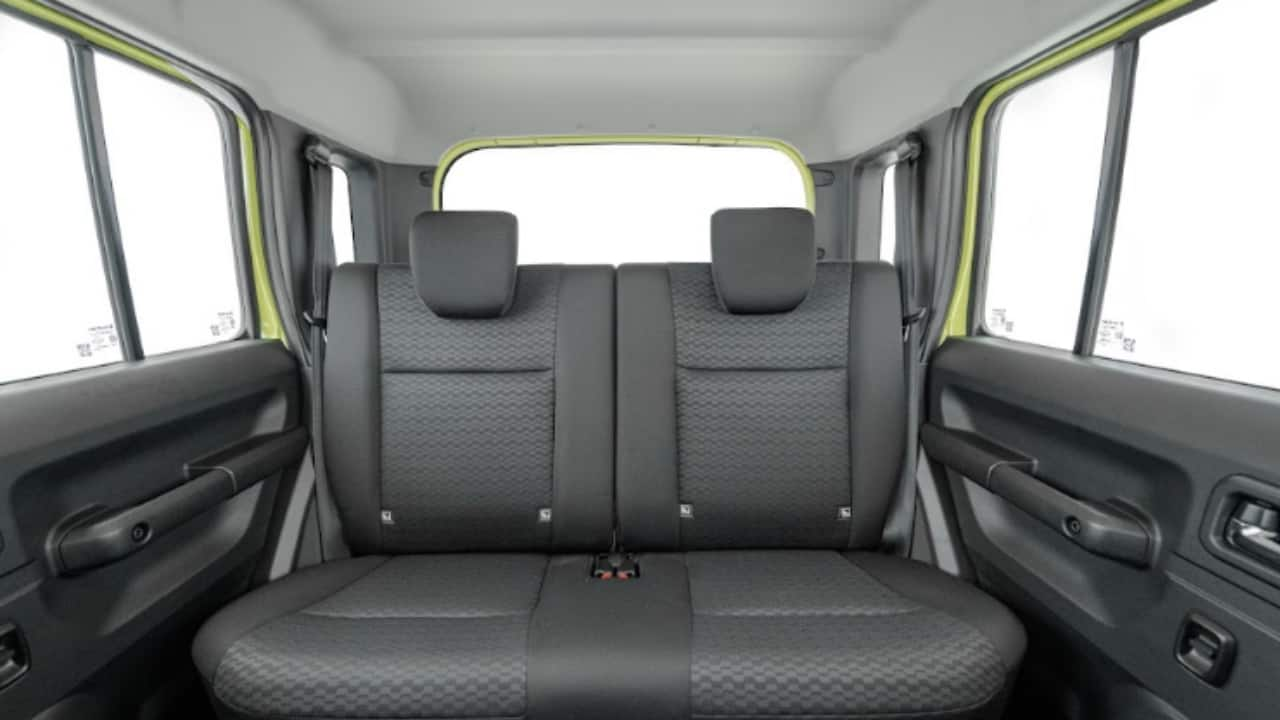
Which begs the question, who is the Jimny for? Maruti Suzuki isn’t expecting this to be a volume success at this price range (Rs 12.74 lakh - Rs 15 lakh) , but they may have underestimated the nostalgia that people hold for the Gypsy. Much like they underestimated this fourth-gen Jimny’s ability to become a global hot seller. Hardcore off-readers, aware of the nuances of off-reading and overlanding, will definitely be booking the Jimny twice over. Yes, it has limitations as a highway capable machine, so it’s unlikely to serve as the only car in one’s garage. While many will go for the Thar’s turbocharged motor, the Jimny is without a shadow of doubt the superior off-roader while the Thar is a better all-rounder. But there’s something about the Jimny’s proportions, its styling and its grit that have put it on the list of the top-three cars I’d like to own. Believe the hyperbole; the Jimny has the makings of a future icon.
Discover the latest Business News, Sensex, and Nifty updates. Obtain Personal Finance insights, tax queries, and expert opinions on Moneycontrol or download the Moneycontrol App to stay updated!